Let me share my favorite twist on yema, a beloved Filipino candy that brings back so many childhood memories. I grew up watching my mom make traditional yema. But when I started cooking on my own, I wanted to create something different.
After many tries in my kitchen (and one completely burned pot), I finally came up with this Pandan Yema recipe. It's made with coconut condensed milk instead of regular condensed milk, and the addition of pandan gives it that familiar Filipino flavor we all love.
What makes this recipe special is how simple it is: no tricky caramel coating needed. Just roll the balls in a mix of caramel crumbles and pandan powder, and you're done. Every time I bring these to family gatherings or give them as pasalubong, people can't believe how creamy and unique they taste.
The best part? You only need four ingredients to make these little green treats. If you love classic yema but want to try something new, this recipe is perfect for you.
Cultural Notes
Yema comes from Spanish influence in Filipino cuisine, traditionally made during fiestas and special occasions. The addition of pandan represents modern Filipino fusion cooking, combining traditional techniques with contemporary flavors.
Jump to:

Why You'll Love This Recipe
- Dairy-free adaptation using coconut condensed milk
- Perfect balance of pandan and caramel flavors
- Healthier version of the traditional recipe
- Make-ahead friendly for parties
- Unique fusion of classic and modern Filipino flavors
- Customizable with different flavor variations
- Great project for beginner candy makers
Ingredients
This recipe carefully balances traditional and modern elements. Coconut condensed milk provides a dairy-free base with tropical undertones that perfectly complement the pandan powder, which adds both color and that distinctive Southeast Asian aroma beloved in Filipino desserts.
Egg yolks create the rich, custard-like texture that defines true yema, while kalamansi zest adds a subtle citrus brightness that cuts through the sweetness. The caramel crumbles in the coating offer a nod to traditional yema's caramelized exterior but in a much simpler form, making this recipe accessible even for beginner candy makers.
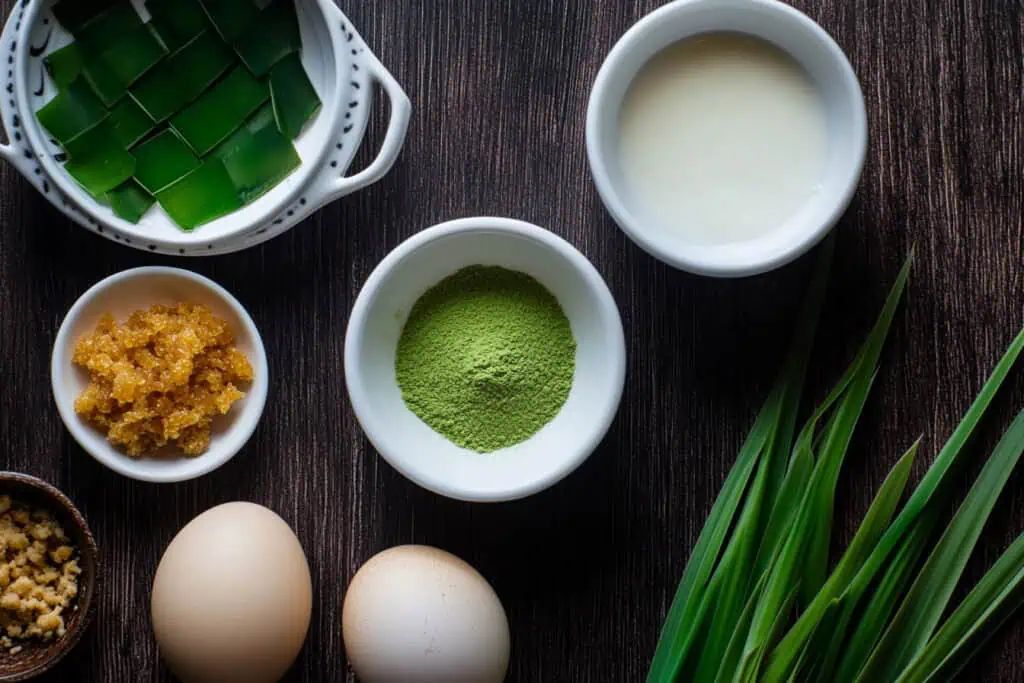
For the Yema Base:
- 1 can (7 oz) coconut condensed milk
- 3 egg yolks
- 1 tablespoon pandan powder
- 1 teaspoon kalamansi zest
For the Coating:
- ¼ cup caramel crumbles
- 1 tablespoon pandan powder
Equipment
- Heavy-bottomed saucepan - Ensures even heat distribution and prevents burning
- Silicone spatula - For constant stirring without scratching the pan
- Candy thermometer (optional) - Helps monitor temperature for perfect consistency
- Small ice cream scoop or measuring spoon - Creates consistent portions
- Mixing bowls - For preparing ingredients and coatings
- Airtight container - Essential for proper storage
- Microplane or zester - For extracting citrus zest
- Parchment paper - Prevents sticking when cooling and storing
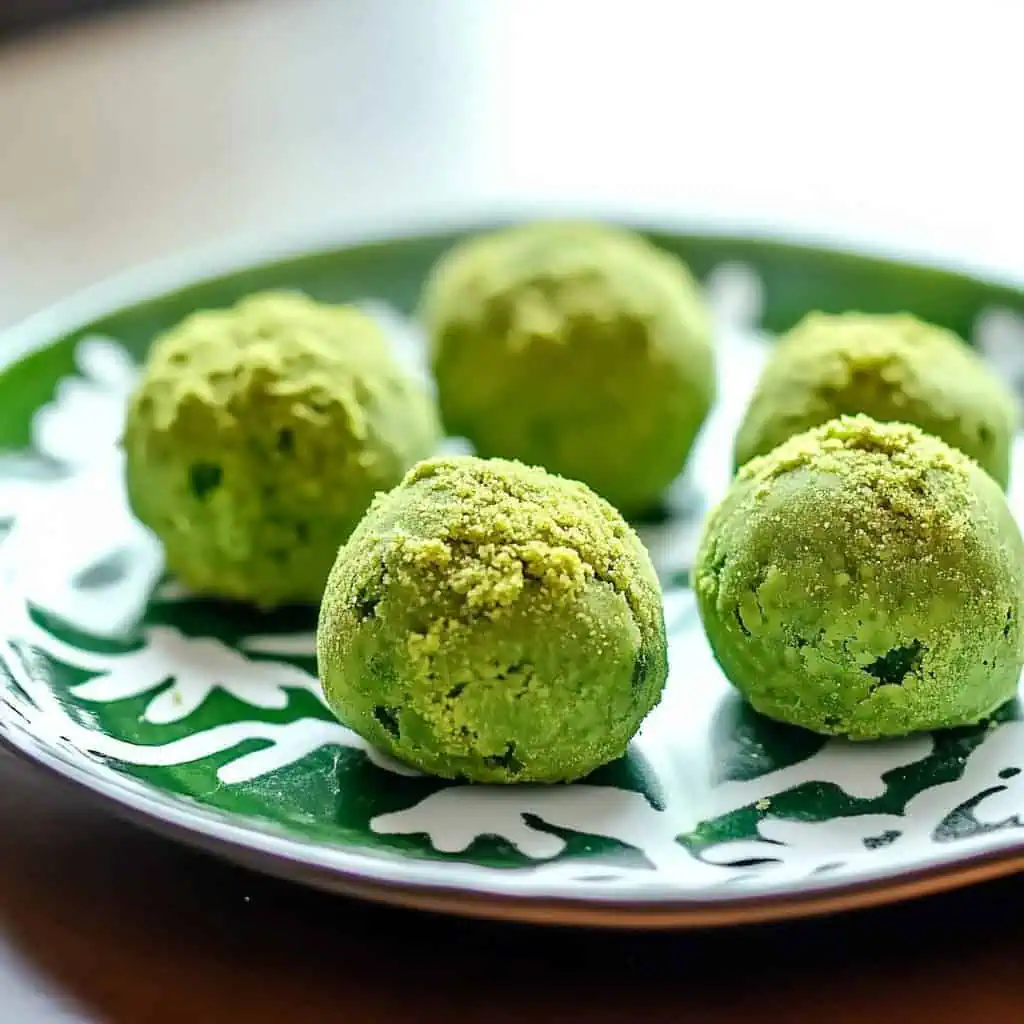
How To Make
- Prepare the mixture: Gather all ingredients and measure them out. In a heavy-bottomed saucepan, combine the coconut condensed milk, egg yolks, pandan powder, and kalamansi zest. Whisk everything together until completely smooth with no streaks.
- Cook the yema: Place the saucepan over very low heat. This is crucial - the heat must be low to prevent burning. Stir continuously with a silicone spatula for about 15-20 minutes. The mixture will gradually thicken as you stir. Watch for when it becomes shiny - this signals it's almost ready. Stop cooking before any oils start to separate, as this indicates overcooking. The mixture will still seem somewhat runny, but this is normal.
- Cool and chill: Remove the pan from heat and let the mixture cool completely to room temperature. Once cooled, transfer to the refrigerator and chill for at least one hour until firm.
- Form the yema balls: After chilling, scoop out portions using a teaspoon (about 1 tablespoon each) and roll them into small balls with your hands. If the mixture sticks to your hands, lightly wet them with cool water.
- Coat and finish: In a small bowl, mix together the caramel crumbles and remaining pandan powder for the coating. Roll each yema ball in this mixture until evenly coated. Place the finished yema in an airtight container and store in the refrigerator. They will keep fresh for up to 5 days.
- Serve: For the best taste and texture, let the yema sit at room temperature for 5 minutes before eating. This allows the texture to soften slightly, making them perfectly chewy.

Tips from Lola's Kitchen
- Use room temperature egg yolks for smoother incorporation with the condensed milk
- Never stop stirring during the cooking process - constant movement prevents burning and ensures even cooking
- Look for the shiny stage before removing from heat - this visual cue indicates perfect doneness
- Low and slow is the key - patience yields the best results with yema
- Keep a bowl of ice water nearby to quickly test consistency - a small drop should hold its shape without spreading
- If using fresh pandan leaves instead of powder, blend 4-5 leaves with a little water and strain to extract the essence
- For special occasions, press a single cashew nut into each ball before coating for traditional yema
- Trust your senses - the aroma will change from "eggy" to caramelized when properly cooked
Substitutions
- Kalamansi zest: Orange or lemon zest works well as alternatives
- Coconut condensed milk: Regular condensed milk can be substituted (though the recipe will no longer be dairy-free)
- Pandan powder: Use pandan extract (reduce amount by half) or vanilla extract for a different flavor profile
- Caramel crumbles: Crushed graham crackers or cookie crumbs provide similar texture
- Fresh pandan leaves: 2-3 drops of pandan extract can replace the powder
- Egg yolks: For a vegan version, try using 3 tablespoons of cornstarch mixed with 2 tablespoons of water (texture will be different)
Troubleshooting
Problem: Yema is too soft and won't hold shape
- Cause: Undercooked mixture
- Solution: Return mixture to pan and cook 2-3 minutes longer, stirring constantly
Problem: Yema has grainy texture
- Cause: Overcooked or egg proteins coagulated
- Solution: Add warm water, 1 teaspoon at a time, and whisk vigorously to smooth out
Problem: Mixture won't set even after refrigeration
- Cause: Too much liquid or insufficient cooking time
- Solution: Cook longer to reduce moisture or add 1 teaspoon cornstarch during cooking
Problem: Bitter taste
- Cause: Burned bottom or scorched mixture
- Solution: Use lower heat, stir constantly, and ensure your pan has a thick, even bottom
Problem: Coating doesn't stick well
- Cause: Yema surface too smooth or wet
- Solution: Let balls sit at room temperature for 5 minutes before coating or press coating in firmly with fingers
Storage & Reheating
- Refrigeration: Store in an airtight container for up to 5 days
- Room temperature: Can be kept at room temperature for up to 8 hours during parties
- Do not freeze: Freezing changes the texture negatively
- Serving: Bring to room temperature for 5-10 minutes before serving for optimal texture
- Layering: Place parchment paper between layers to prevent sticking
- Container material: Glass containers maintain flavor better than plastic
- Away from odors: Store away from strong-smelling foods as yema can absorb odors
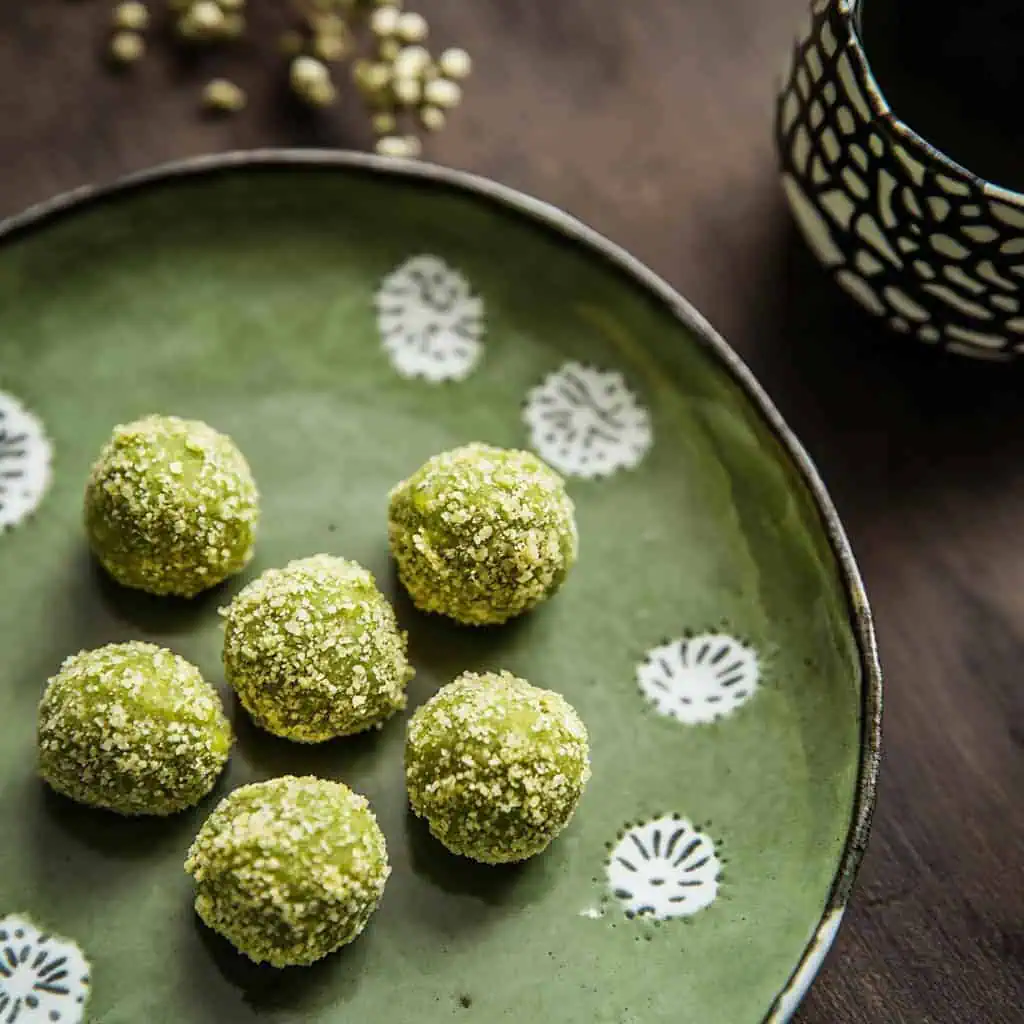
FAQ
Why is my yema not setting properly?
Ensure you've cooked it long enough to reduce moisture. The mixture should be shiny but not separated. Refrigeration for at least one hour is essential.
Can I make this recipe in advance for a party?
Yes! These yema balls can be prepared up to 5 days ahead. Store them in the refrigerator in an airtight container, layered with parchment paper.
Is pandan powder absolutely necessary?
While pandan provides the authentic flavor and signature green color, you can substitute with vanilla extract for a more traditional yema. The taste will be different but still delicious.
Why use coconut condensed milk instead of regular?
Coconut condensed milk makes this recipe dairy-free and adds a subtle tropical flavor that complements the pandan. Regular condensed milk works perfectly fine if preferred.
How do I know exactly when the yema mixture is done cooking?
The mixture becomes shiny and slightly pulls away from the sides of the pan. When you drag your spatula through it, it should leave a momentary trail before filling in. Stop cooking before any oils separate.
Can I add nuts to this recipe?
Absolutely! Traditional yema often includes cashews. Press a single cashew into each ball before coating for an authentic touch.
How can I make the yema less sweet?
Reduce the amount of condensed milk slightly and increase egg yolks by one. This shifts the ratio toward the less sweet component.
Why did my mixture curdle or separate?
This happens when the heat is too high or cooking continues too long. Use very low heat and stop cooking when the mixture is thick but still glossy.
Can children help make this recipe?
Children can help with measuring ingredients and rolling the cooled mixture into balls. The cooking process requires constant attention and should be handled by adults.
What's the difference between this and traditional yema?
Traditional yema uses regular condensed milk without pandan and is often coated in caramel. This version uses coconut condensed milk, adds pandan flavor, and simplifies the coating process.
Related
Looking for other recipes like this? Try these:

Pandan Yema (Filipino Custard Candy)
Equipment
- Heavy-bottomed saucepan (makapal na kawali) Ensures even heat distribution and prevents burning
- Silicone spatula (panghalo) For constant stirring without scratching the pan
- Candy thermometer (optional) To monitor temperature
- Small ice cream scoop or measuring spoon For consistent portioning
- Mixing bowls (mangkok) For preparing ingredients
- Airtight container (lalagyan) For storage
- Microplane or zester For citrus zest
- Parchment Paper For preventing sticking
Ingredients
For the Yema Base:
- 1 can 7 oz Coconut Condensed Milk
- 3 Egg Yolks dilaw ng itlog
- 1 Tablespoon Pandan Powder
- 1 Teaspoon Kalamansi Zest
For the Coating:
- ¼ Cup Caramel Crumbles
- 1 Tablespoon Pandan Powder
Instructions
- Begin by gathering all ingredients and measuring them out. Set a heavy-bottomed saucepan on your counter. In the saucepan, combine the coconut condensed milk, egg yolks, pandan powder, and kalamansi zest. Whisk everything together until completely smooth with no streaks.
- Place the saucepan over very low heat. This is important - the heat must be low to prevent burning. Start stirring continuously with a silicone spatula. You'll need to keep stirring without stopping for about 15-20 minutes. The mixture will gradually thicken as you stir. Watch for when the mixture becomes shiny - this is your signal that it's almost ready. Stop cooking before any oils start to separate, as this means it's overcooked. The mixture will still seem a bit runny, but this is normal.
- Remove the pan from heat and let the mixture cool completely to room temperature. Once it reaches room temperature, transfer it to the refrigerator and chill for at least one hour until firm.
- After chilling, scoop out portions using a teaspoon (about 1 tablespoon each) and roll them into small balls with your hands. If the mixture sticks to your hands, you can lightly wet them with cool water.
- In a small bowl, mix together the caramel crumbles and remaining pandan powder for the coating. Roll each yema ball in this mixture until evenly coated. Place the finished yema in an airtight container and store in the refrigerator. They will keep fresh for up to 5 days, though they rarely last that long.
- For the best taste, let the yema sit at room temperature for 5 minutes before eating. This allows the texture to soften slightly, making them perfectly chewy.
Tips from Lola's Kitchen
- Use room temperature egg yolks for smoother mixing
- Never stop stirring
- Look for the shiny stage before removing from heat
- If mixture becomes grainy, add 1 teaspoon warm water
- Wet your hands slightly when rolling to prevent sticking
- Keep a bowl of ice water nearby to test consistency
Nutrition
The Story Behind Pandan Yema
Yema, which means "egg yolk" in Spanish, first arrived in the Philippines during the Spanish colonial period. In those days, Spanish nuns used egg yolks to starch their habits, leaving them with plenty of yolks that eventually became the base for this beloved Filipino candy. Over time, yema became a staple at fiestas, family gatherings, and local bakeries across the Philippines, known for its signature creamy texture and sweet, custard-like flavor.
Traditional yema is made by cooking egg yolks with condensed milk until thick, then coating the mixture in caramel. It's often shaped into pyramids or small balls and wrapped in colorful cellophane, making it a popular pasalubong (homecoming gift) choice. In many Filipino households, the art of making yema has been passed down through generations, with each family adding their own special touch to the recipe.
This modern pandan version reflects how Filipino cuisine continues to evolve while honoring its roots. By incorporating pandan, a fragrant leaf widely used in Southeast Asian cooking, and switching to coconut condensed milk, this recipe offers a healthier, dairy-free alternative that's still unmistakably Filipino. The bright green color from the pandan powder makes it instantly recognizable at dessert tables, while the caramel crumbles provide that familiar crunch without the challenging process of making traditional caramel coating.
Today, yema remains a symbol of Filipino ingenuity in the kitchen, where beloved recipes are constantly reimagined to suit changing tastes and dietary needs. Whether enjoyed as a quick merienda (snack) with afternoon coffee, packed as baon (packed meal) for school children, or given as a thoughtful homemade gift, pandan yema represents the perfect blend of tradition and innovation in modern Filipino dessert-making.
For many Filipinos living abroad, making yema is a way to stay connected to their heritage while introducing their culture to friends through food. This pandan version often becomes a conversation starter, leading to discussions about Filipino flavors and the creative ways traditional recipes are being adapted for contemporary kitchens.
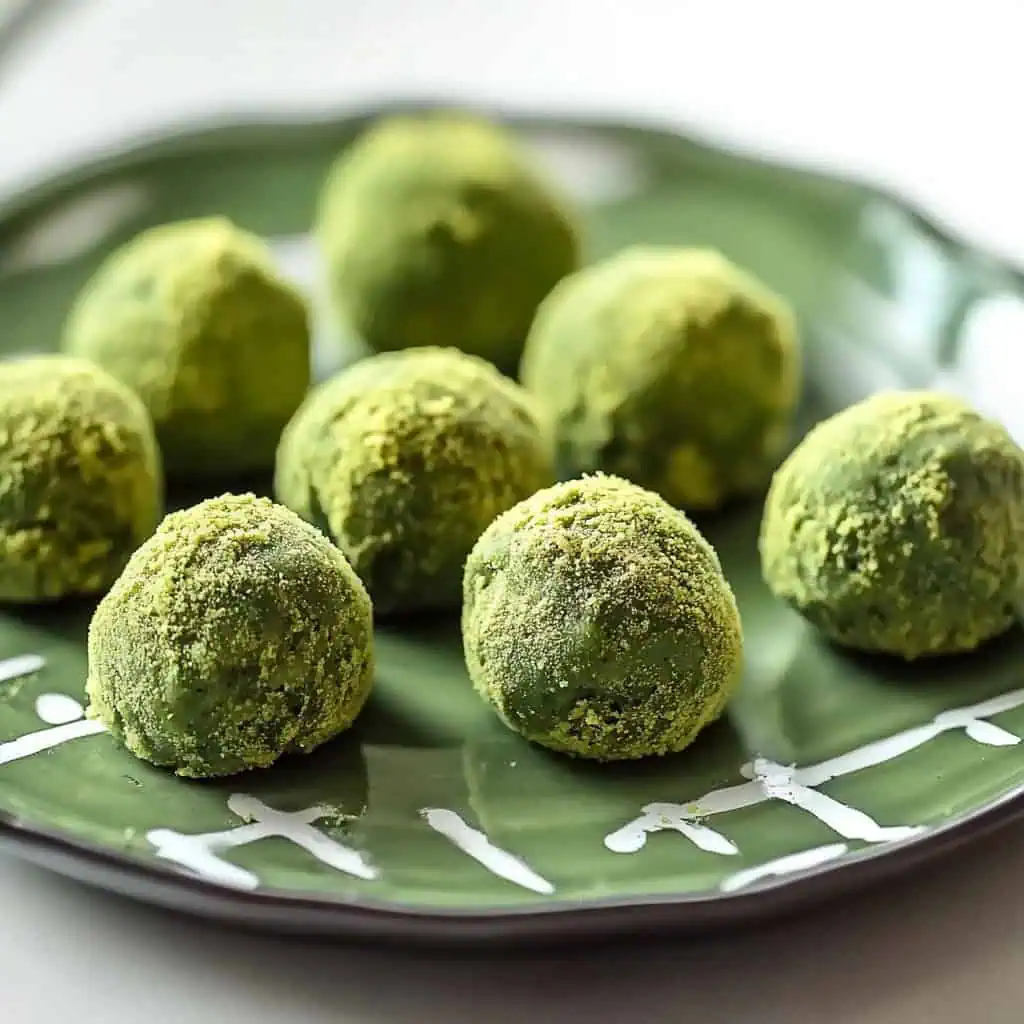





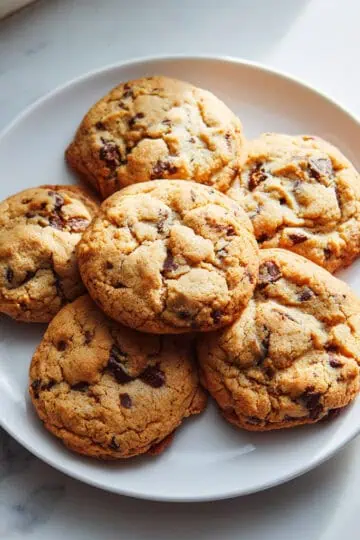
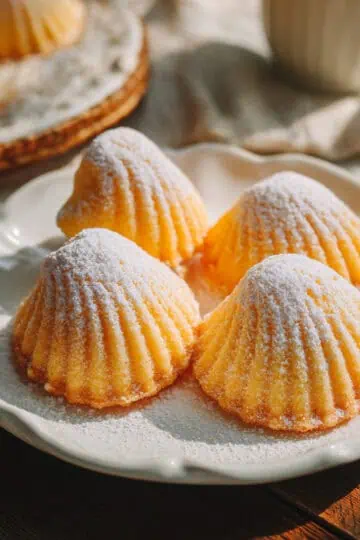
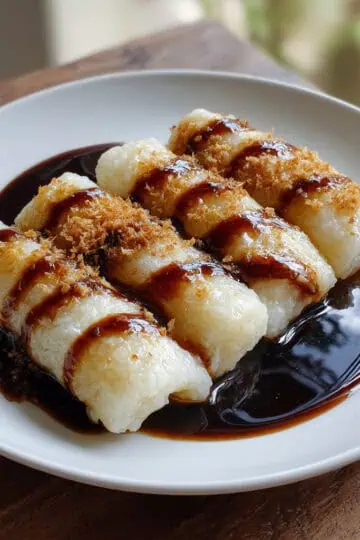

Comments
No Comments